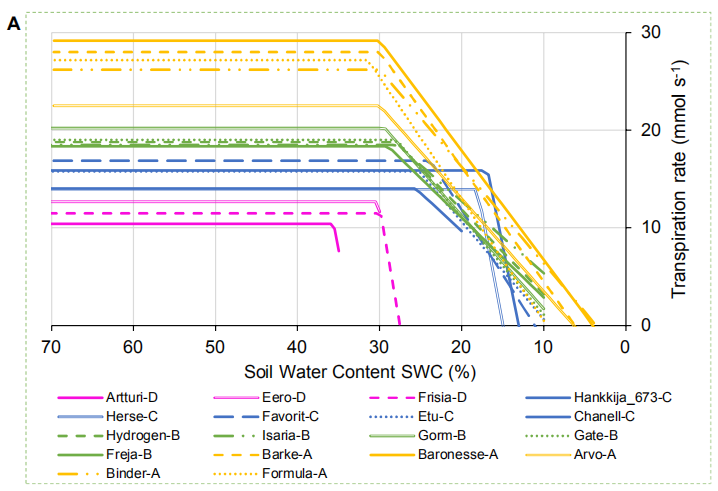品质至上,客户至上,您的满意就是我们的目标
当前位置: 首页 > 新闻动态
科学家利用Plantarray植物功能生理表型研究系统发表大麦研究文章
发表时间: 点击:246
来源:北京博普特科技有限公司
分享:
最近,以色列科学家利用Plantarray植物功能生理表型研究系统发表了题为“Precision phenotyping of a barley diversity set reveals distinct drought response strategies”的文章,探讨了大麦对不同干旱的应对策略。
大麦多样性集的精确表型分析揭示了不同的干旱应对策略
摘要
植物对干旱表现出广泛的反应和适应机制。在干旱期间,水分流失和CO2吸收对生长的权衡是通过对土壤含水量(SWC)等因素的气孔孔径的调节来介导的。我们早些时候在几个参考大麦品种中发现了两种不同的用水策略,这些参考品种因蒸腾减少的SWC而有所不同:节水(“等水”和耗水(“非等水”)。我们提出,在生长季节降水概率增加的气候中,等水策略可以降低早期干旱的风险,而非等水策略与具有终端干旱的环境或干旱期短且季节变化小的环境一致。在这里,我们研究了跨越20世纪欧洲大麦育种的单系大麦多样性集的干旱响应,并确定了具有第三种对干旱的动态蒸腾响应的几株品系。我们发现活力和蒸腾作用之间存在很强的正相关关系,两者的动态组最高。但这些品系在比等水组更高的SWC下减少了每日蒸腾。虽然动态品系,特别是 cv Hydrogen 和 Baronesse,在恢复初始生长速率方面并不是最有弹性的,但它们强大的初始活力和初始蒸腾速率的高回报率意味着它们的生长在从干旱中恢复期间仍然超过了更具弹性的品系。研究结果将有助于确定适合未来气候情景的大麦生理学表型。
Precision phenotyping of a barley diversity set reveals distinct drought response strategies
Abstract
Plants exhibit a wide array of responses and adaptive mechanisms to drought. During drought, the trade-off between water loss and CO2 uptake for growth is mediated by the regulation of stomatal aperture in response to soil water content (SWC), among other factors. We earlier identified, in a few reference varieties of barley that differed by the SWC at which transpiration was curtailed, two divergent water use strategies: water-saving (
“isohydric” and water-spending (“anisohydric”). We proposed that an isohydric strategy may reduce risk from early droughts in climates where the probability of precipitation increases during the growing season, whereas an anisohydric strategy is consistent with environments having terminal droughts, or with those where dry periods are short and show little seasonal variation. Here, we have examined drought response in an-line barley diversity set that spans 20th century European barley breeding and identified a several lines with a third, dynamic transpirational response to drought. We found a strong positive correlation between vigor and transpiration, the dynamic group being highest for both. However, these lines curtailed daily transpiration at a higher SWC than the isohydric group . While the dynamic lines, particularly cv Hydrogen and Baronesse, were not the most resilient in terms of restoring initial growth rates, their strong initial vigor and high return to initial transpiration rates meant that their growth nevertheless surpassed more resilient lines during recovery from drought. The results will be of use for defining barley physiological ideotypes suited to future climate scenarios.


